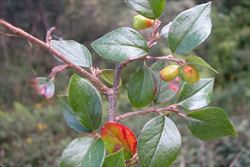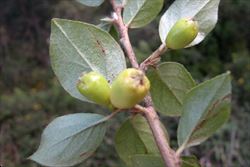Click on images to enlarge

stems and leaves (Photo: Greg Jordan)

close-up of leaf undersides and immature fruit (Photo: Greg Jordan)
Scientific Name
Cotoneaster symondsii
Synonyms
Cotoneaster simonsii Baker
Family
Malaceae (New South Wales)Rosaceae (Queensland, the ACT, Victoria, Tasmania, South Australia and Western Australia)
Common Names
cotoneaster, Himalayan cotoneaster, khasia berry, Simon's cotoneaster
Origin
This species is native to the Himalayas (i.e. India, Bhutan and Nepal) and south-eastern Asia (i.e. Myanmar).
Cultivation
Cultivated as a garden plant in the southern parts of Australia.
Naturalised Distribution
Naturalised in the cooler parts of south-eastern Australia (i.e. in south-eastern South Australia, Tasmania, southern Victoria and on the New South Wales central tablelands). Possibly also naturalised in the ACT.
Naturalised overseas in Europe, New Zealand and western USA (i.e. Washington and Oregon).
Habitat
A weed of gardens, urban bushland, open woodlands, forest margins, roadsides, forestry plantations, disturbed sites and waste areas mainly in temperate regions.
Habit
An upright (i.e. erect) or arching shrub growing up to 4 m tall that may loose its leaves during winter (i.e. it is sometimes deciduous).
Distinguishing Features
- an upright or arching shrub growing up to 4 m tall that often loses its leaves during winter.
- its younger stems are densely covered in small brownish hairs.
- its relatively small leaves (about 25 mm long and 15 mm wide) have shiny upper surfaces with a sparse covering of close-lying hairs.
- its white to pale pink flowers have five petals (2-3 mm long) and are borne in small clusters of 1-4 flowers.
- its small shiny, egg-shaped, 'berries' (5-10 mm long) turn orange-red or scarlet when mature.
Stems and Leaves
The stems are upright (i.e. erect) or become slightly arched as the plant matures. Younger stems are densely covered in small brownish-coloured hairs, while older stems become hairless (i.e. glabrous) and are a brownish-grey colour.
The alternately arranged leaves are relatively small (about 25 mm long and 15 mm wide) and egg-shaped in outline (i.e. ovate) or diamond-shaped (i.e. rhomboid). Their tips are sharply pointed (i.e. the apices are acute) and they tend to be crowded in clusters, on short side-branches, along the stems. The upper leaf surfaces are shiny and have a sparse covering of close-lying (i.e. appressed) hairs while the leaf undersides are greyish-green and also sparsely hairy (i.e. sparsely pubescent).
Flowers and Fruit
The small white or pale pink flowers have five petals (2-3 mm long) and are borne in small clusters containing only 1-4 flowers. These flower clusters are arranged along the branches or on short side-shoots. Flowering occurs mostly during late spring and summer.
The fruit is a small (5-10 mm long) egg-shaped (i.e. ovoid) 'berry' (i.e. pome). These fruit turn orange-red or scarlet red as they mature and are very shiny in appearance.
Reproduction and Dispersal
This plant reproduces by seed, which are commonly spread by birds that eat the brightly coloured fruit. The seeds may also be spread in dumped garden waste, and if plants are cut down they will produce suckers from the base (i.e. crown).
Environmental Impact
Khasia berry (Cotoneaster simonsii) is regarded as an environmental weed in Victoria, Tasmania and South Australia, and as a potential environmental weed in the ACT. It invades dry forests and open woodlands adjacent to urban areas (e.g. it is naturalised in Scott Creek Conservation Park in Adelaide). This species, like the other cotoneasters, forms thickets under trees and dense infestations will shade out the native ground flora and impede the regeneration of overstorey plants.
Other Impacts
The fruit of this species are poisonous to humans. Khasia berry (Cotoneaster simonsii) may also act as a host for bacterial fireblight, a disease of orchards.
Legislation
This species is declared under legislation in the following states and territories:
- ACT: C4 - prohibited pest plant (a pest plant whose propagation and supply is prohibited).
- Western Australia: Unassessed - this species is declared in other states or territories and is prohibited until assessed via a weed risk assessment (throughout the entire state).
Similar Species
Khasia berry (Cotoneaster simonsii) is very similar to grey cotoneaster (Cotoneaster franchetii), large-leaved cotoneaster (Cotoneaster glaucophyllus), silver-leaved cotoneaster (Cotoneaster pannosus), willow-leaved (Cotoneaster salicifolius) and milk-flower cotoneaster (Cotoneaster coriaceus). These species can be distinguished by the following differences:
- khasia berry (Cotoneaster simonsii) has relatively small leaves (about 25 mm long) with bright green upper leaf surfaces that are shiny and have a sparse covering of close-lying (i.e. appressed) hairs. The lower surface of the leaves are greyish-green and also sparsely hairy (i.e. sparsely pubescent). The white or pale pink coloured flowers are borne in small clusters (with only 1-4 flowers). Its shiny fruit turn orange-red or scarlet red in colour as they mature.
- grey cotoneaster (Cotoneaster franchetii) has relatively small leaves (20-35 mm long) with greyish-green upper surfaces that are somewhat hairy (i.e. pubescent) when they are young, but become hairless (i.e. glabrous) and shiny in appearance as they mature. The lower surface of the leaves are silvery or whitish in colour and densely hairy (i.e. pubescent). The pink or pinkish-white flowers have relatively upright (i.e. erect) petals and are borne in medium-sized clusters (usually with 5-15 flowers). Its fruit turn orange or pinkish-orange as they mature.
- large-leaved cotoneaster (Cotoneaster glaucophyllus) has relatively large leaves (20-80 mm long) with upper surfaces that are smooth and dark green in colour. The lower surface of the leaves are initially greyish-green and covered in whitish hairs (i.e. they are pubescent) but these hairs often wear off as the leaves mature, leaving pale green or slightly bluish-green and hairless (i.e. glabrous) undersides. The white flowers have spreading petals and are usually borne in large clusters (usually with 20-60 flowers). Its relatively glossy fruit turn bright red as they mature.
- silver-leaved cotoneaster (Cotoneaster pannosus) has relatively small leaves (10-40 mm long) with dull greyish-green upper surfaces that are somewhat hairy (i.e. pubescent). The lower surface of the leaves are silvery or whitish and densely hairy (i.e. pubescent). The white flowers have spreading petals and are borne in medium-sized clusters (usually with 6-20 flowers). Its relatively dull and sometimes hairy fruit turn red as they mature.
- willow-leaved cotoneaster (Cotoneaster salicifolius) has relatively long and narrow leaves (25-90 mm long) with dark green, glossy and hairless (i.e. glabrous) upper surfaces that have prominent veins impressed into them. The lower surface of the leaves are greyish in colour and hairy (i.e. pubescent). The white flowers have spreading petals and are borne in medium-sized clusters. Its fruit turn bright red as they mature.
- milk-flower cotoneaster (Cotoneaster coriaceus) has relatively large leaves (up to 75 mm long) with shiny dark green and mostly hairless (i.e. glabrous) upper surfaces that have prominent veins impressed into them. The lower surface of the leaves are whitish in colour and densely hairy (i.e. pubescent). The milky white flowers are borne in medium-sized clusters and its fruit turn orange-red or red in colour as they mature.
Khasia berry (Cotoneaster simonsii) is also relatively similar to the firethorns (Pyracantha spp.) and the hawthorns (Crataegus spp.). However, the firethorns (Pyracantha spp.) have stems that are armed with spines and the hawthorns (Crataegus spp.) have deeply lobed leaves that are also often coarsely toothed (i.e. serrate) towards their tips and stems that are also armed with stout thorns.

